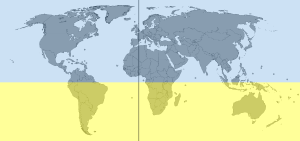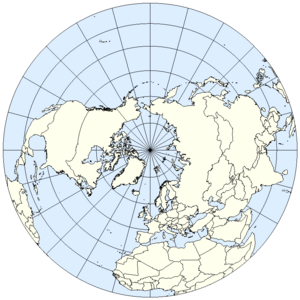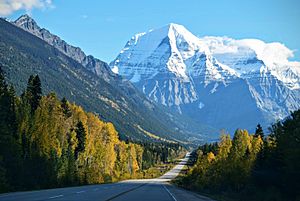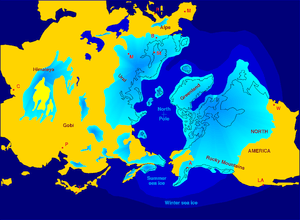Northern Hemisphere facts for kids


The Northern Hemisphere is the half of Earth that is north of the Equator. Think of the Equator as an imaginary line that circles the middle of our planet. Everything above this line is part of the Northern Hemisphere.
Because Earth is tilted slightly (about 23.4 degrees), the seasons are different in the Northern Hemisphere compared to the Southern Hemisphere. For example, winter in the Northern Hemisphere usually starts around December 21st and ends around March 20th. Summer then lasts from the June solstice (around June 21st) until the September equinox (around September 23rd). These dates can shift a little each year.
Ocean currents in the Northern Hemisphere can also affect weather patterns. For instance, events like El Niño–Southern Oscillation can change the climate along northern coasts.
About 60.7% of the Northern Hemisphere is covered by water, while 80.9% of the Southern Hemisphere is water. However, the Northern Hemisphere has most of Earth's land, about 67.3%. The continents of North America and most of Eurasia are completely in the Northern Hemisphere. Also, about two-thirds of Africa and a small part of South America are found here.
Contents
Understanding Northern Hemisphere Climate and Geography
The Northern Hemisphere has seen many big changes in its climate over millions of years.
Ice Ages and Warm Periods
During the last 2.5 million years, Earth went through many cold periods called ice ages. Huge sheets of ice, sometimes kilometers thick, covered large parts of Europe and North America. These cold times lasted for about 40,000 to 100,000 years.
Between these ice ages were warmer, shorter times called interglacials, which lasted about 10,000 to 15,000 years. We are currently in one of these warmer periods, called the Holocene. The last big ice age ended about 10,000 years ago.
Climate Zones of the North
The Northern Hemisphere has different climate zones:
The Arctic Region
The Arctic is the area around the North Pole. It has very cold winters and cool summers. Most of the rain and snow here falls as snow. If you are inside the Arctic Circle (a special line of latitude), you'll experience days in summer when the Sun never sets. In winter, there are days when the Sun never rises. The closer you get to the North Pole, the longer these periods of endless day or night last.
The Northern Temperate Zone
Between the Arctic Circle and the Tropic of Cancer (another important line of latitude) is the Northern temperate zone. In these areas, the changes between summer and winter are usually mild. It's not usually extremely hot or extremely cold, but the weather can be quite unpredictable.
Tropical Regions
Tropical regions are found between the Tropic of Cancer and the Equator. These areas are generally hot all year round. They usually have a rainy season during the summer months and a dry season in the winter.

How the Earth's Spin Affects Weather
In the Northern Hemisphere, things moving across or above Earth's surface tend to turn to the right. This is due to something called the Coriolis effect. Because of this effect, large movements of air or water often form giant clockwise spirals, called gyres. You can see this clearly in the North Atlantic and North Pacific oceans.
This is also why high pressure weather systems in the Northern Hemisphere have air that spins clockwise. On the other hand, hurricanes and tropical storms (which are huge low-pressure systems) spin counter-clockwise in the Northern Hemisphere.
Sun, Moon, and Stars in the North
If you look at a sundial in the Northern Hemisphere, its shadow moves clockwise. This is because the Sun tends to be in the southern part of the sky at its highest point during the day.
When you look at the Moon from the Northern Hemisphere, it appears upside down compared to how it looks from the Southern Hemisphere. Also, the North Pole points away from the center of our Milky Way galaxy. This means the Milky Way looks fainter in the Northern Hemisphere. This is actually good for astronomers, as it makes it easier to observe distant galaxies and stars without the bright glow of our own galaxy getting in the way!
People in the Northern Hemisphere
As of 2015, about 6.4 billion people live in the Northern Hemisphere. That's around 87% of all the people on Earth!
Continents, Countries, and Oceans in the Northern Hemisphere
See also
 In Spanish: Hemisferio norte para niños
In Spanish: Hemisferio norte para niños


